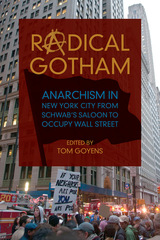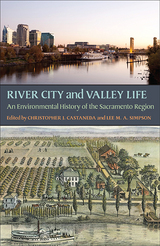3 books by CASTANEDA, CHRISTOPHER J.

Radical Gotham
Anarchism in New York City from Schwab's Saloon to Occupy Wall Street
Edited by Tom Goyens
University of Illinois Press, 2017
New York City's identity as a cultural and artistic center, as a point of arrival for millions of immigrants sympathetic to anarchist ideas, and as a hub of capitalism made the city a unique and dynamic terrain for anarchist activity. For 150 years, Gotham's cosmopolitan setting created a unique interplay between anarchism's human actors and an urban space that invites constant reinvention. Tom Goyens gathers essays that demonstrate anarchism's endurance as a political and cultural ideology and movement in New York from the 1870s to 2011. The authors cover the gamut of anarchy's emergence in and connection to the city. Some offer important new insights on German, Yiddish, Italian, and Spanish-speaking anarchists. Others explore anarchism's influence on religion, politics, and the visual and performing arts. A concluding essay looks at Occupy Wall Street's roots in New York City's anarchist tradition. Contributors: Allan Antliff, Marcella Bencivenni, Caitlin Casey, Christopher J. Castañeda, Andrew Cornell, Heather Gautney, Tom Goyens, Anne Klejment, Alan W. Moore, Erin Wallace, and Kenyon Zimmer.
[more]

REGULATED ENTERPRISE
NATURAL GAS PIPELINES AND NORTHEASTERN M
CHRISTOPHER J. CASTANEDA
The Ohio State University Press, 1992

River City and Valley Life
An Environmental History of the Sacramento Region
Christopher J. Castaneda
University of Pittsburgh Press, 2013
Often referred to as “the Big Tomato,” Sacramento is a city whose makeup is significantly more complex than its agriculture-based sobriquet implies. In River City and Valley Life, seventeen contributors reveal the major transformations to the natural and built environment that have shaped Sacramento and its suburbs, residents, politics, and economics throughout its history.
The site that would become Sacramento was settled in 1839, when Johann Augustus Sutter attempted to convert his Mexican land grant into New Helvetia (or “New Switzerland”). It was at Sutter’s sawmill fifty miles to the east that gold was first discovered, leading to the California Gold Rush of 1849. Nearly overnight, Sacramento became a boomtown, and cityhood followed in 1850.
Ideally situated at the confluence of the American and Sacramento Rivers, the city was connected by waterway to San Francisco and the surrounding region. Combined with the area’s warm and sunny climate, the rivers provided the necessary water supply for agriculture to flourish. The devastation wrought by floods and cholera, however, took a huge toll on early populations and led to the construction of an extensive levee system that raised the downtown street level to combat flooding. Great fortune came when local entrepreneurs built the Central Pacific Railroad, and in 1869 it connected with the Union Pacific Railroad to form the first transcontinental passage. Sacramento soon became an industrial hub and major food-processing center. By 1879, it was named the state capital and seat of government.
In the twentieth century, the Sacramento area benefitted from the federal government’s major investment in the construction and operation of three military bases and other regional public works projects. Rapid suburbanization followed along with the building of highways, bridges, schools, parks, hydroelectric dams, and the Rancho Seco nuclear power plant, which activists would later shut down. Today, several tribal gaming resorts attract patrons to the area, while “Old Sacramento” revitalizes the original downtown as it celebrates Sacramento’s pioneering past.
This environmental history of Sacramento provides a compelling case study of urban and suburban development in California and the American West. As the contributors show, Sacramento has seen its landscape both ravaged and reborn. As blighted areas, rail yards, and riverfronts have been reclaimed, and parks and green spaces created and expanded, Sacramento’s identity continues to evolve. As it moves beyond its Gold Rush, Transcontinental Railroad, and government-town heritage, Sacramento remains a city and region deeply rooted in its natural environment.
The site that would become Sacramento was settled in 1839, when Johann Augustus Sutter attempted to convert his Mexican land grant into New Helvetia (or “New Switzerland”). It was at Sutter’s sawmill fifty miles to the east that gold was first discovered, leading to the California Gold Rush of 1849. Nearly overnight, Sacramento became a boomtown, and cityhood followed in 1850.
Ideally situated at the confluence of the American and Sacramento Rivers, the city was connected by waterway to San Francisco and the surrounding region. Combined with the area’s warm and sunny climate, the rivers provided the necessary water supply for agriculture to flourish. The devastation wrought by floods and cholera, however, took a huge toll on early populations and led to the construction of an extensive levee system that raised the downtown street level to combat flooding. Great fortune came when local entrepreneurs built the Central Pacific Railroad, and in 1869 it connected with the Union Pacific Railroad to form the first transcontinental passage. Sacramento soon became an industrial hub and major food-processing center. By 1879, it was named the state capital and seat of government.
In the twentieth century, the Sacramento area benefitted from the federal government’s major investment in the construction and operation of three military bases and other regional public works projects. Rapid suburbanization followed along with the building of highways, bridges, schools, parks, hydroelectric dams, and the Rancho Seco nuclear power plant, which activists would later shut down. Today, several tribal gaming resorts attract patrons to the area, while “Old Sacramento” revitalizes the original downtown as it celebrates Sacramento’s pioneering past.
This environmental history of Sacramento provides a compelling case study of urban and suburban development in California and the American West. As the contributors show, Sacramento has seen its landscape both ravaged and reborn. As blighted areas, rail yards, and riverfronts have been reclaimed, and parks and green spaces created and expanded, Sacramento’s identity continues to evolve. As it moves beyond its Gold Rush, Transcontinental Railroad, and government-town heritage, Sacramento remains a city and region deeply rooted in its natural environment.
[more]
READERS
Browse our collection.
PUBLISHERS
See BiblioVault's publisher services.
STUDENT SERVICES
Files for college accessibility offices.
UChicago Accessibility Resources
home | accessibility | search | about | contact us
BiblioVault ® 2001 - 2024
The University of Chicago Press









